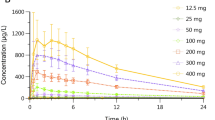Abstract
Objective: Nisoldipine, a calcium antagonist of the dihydropyridine class, has been used in the treatment of hypertension and angina pectoris. A new controlled-release dosage form (nisoldipine coat-core, NCC) has been developed to allow once daily dosing. In addition to a formal food interaction study as requested by regulatory authorities for controlled-release dosage forms, a subsequent study was conducted to determine the clinical relevance of the changes in nisoldipine plasma concentration vs time profiles seen in the food effect study.
Methods: After a placebo run-in phase of 6 days, 12 hypertensive patients started treatment with 20 mg NCC once daily (days 0–3, 5–6, 8–9). On days 4, 7 and 10 the NCC was substituted for 5, 10 and 20 mg nisoldipine solution, respectively, in order to obtain nisoldipine plasma concentration vs time profiles comparable to the ones resulting from the concomitant intake of food and NCC. Simultaneous measurements of blood pressure (BP) and nisoldipine concentration were performed on days 3, 4, 7 and 10.
Results: The relationship between nisoldipine plasma concentrations and percentage reduction in BP [diastolic (DBP) and systolic (SBP), supine and standing] could be described by an Emax model. The mean maximum reduction (Emax) relative to baseline was about 36.4% and 37.7% (DBP, supine and standing) and 27.9% and 29.2% (SBP, supine and standing), respectively. The interindividual variability (% CV) in Emax was low, ranging from 17.6% to 28.8%. The mean nisoldipine plasma concentration corresponding to 50% of the maximum effect (EC50) ranged between 0.99 and 2.62 μg · l–1 with a pronounced interindividual variability (% CV) of 89.5–108.8%. Mean Cmax values after administration of the 30 and 40 mg NCC together with food were 4.5 and 7.5 μg · l–1, respectively. Based on the concentration-effect relationship established in the present study, the effect achieved with a concentration of 7.5 μg · l–1 will be about 77% of Emax for DBP and about 88% of Emax for SBP, respectively.
Conclusion: At the time of maximum plasma concentration the additional decrease in BP relative to baseline due to the food effect will be about 7–15% for DBP and 3–9% for SBP. After administration of the 10␣mg solution with a mean Cmax of 8.7 μg · l–1, only headache and flush with mild severity have been reported as adverse events. These maximum concentrations are comparable to Cmax values seen after intake of 40 mg NCC with food. With regard to heart rate (HR) there were distinct differences between the two formulations: Following administration of 5, 10 and 20 mg nisoldipine solution, there were dose-dependent increases in HR by a maximum of 4, 12 and 16 beats · min−1, respectively, whereas the HR profile for the NCC was similar to that seen under placebo treatment.
Similar content being viewed by others
Author information
Authors and Affiliations
Additional information
Received: 28 December 1995 / Accepted in revised form: 19 August 1996
Rights and permissions
About this article
Cite this article
Schaefer, H., Heinig, R., Ahr, G. et al. Pharmacokinetic-pharmacodynamic modelling as a tool to evaluate the clinical relevance of a drug-food interaction for a nisoldipine controlled-release dosage form. E J Clin Pharmacol 51, 473–480 (1997). https://doi.org/10.1007/s002280050233
Issue Date:
DOI: https://doi.org/10.1007/s002280050233




